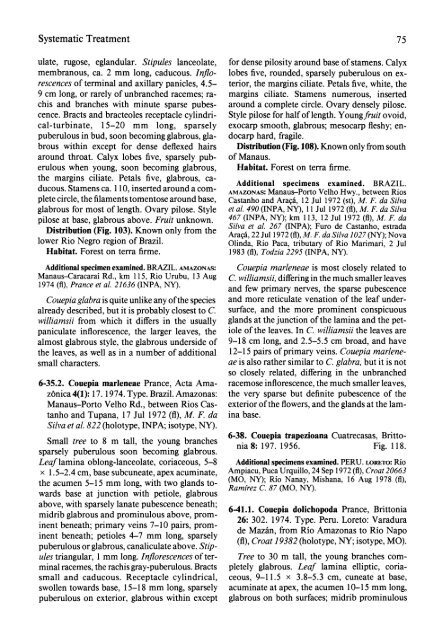flora neotropica - CNCFlora
flora neotropica - CNCFlora
flora neotropica - CNCFlora
Create successful ePaper yourself
Turn your PDF publications into a flip-book with our unique Google optimized e-Paper software.
Systematic Treatment75<br />
ulate, rugose, eglandular. Stipules lanceolate,<br />
membranous, ca. 2 mm long, caducous. Inflorescences<br />
of terminal and axillary panicles, 4.5-<br />
9 cm long, or rarely of unbranched racemes; rachis<br />
and branches with minute sparse pubescence.<br />
Bracts and bracteoles receptacle cylindrical-turbinate,<br />
15-20 mm long, sparsely<br />
puberulous in bud, soon becoming glabrous, glabrous<br />
within except for dense deflexed hairs<br />
around throat. Calyx lobes five, sparsely puberulous<br />
when young, soon becoming glabrous,<br />
the margins ciliate. Petals five, glabrous, caducous.<br />
Stamens ca. 110, inserted around a complete<br />
circle, the filaments tomentose around base,<br />
glabrous for most of length. Ovary pilose. Style<br />
pilose at base, glabrous above. Fruit unknown.<br />
Distribution (Fig. 103). Known only from the<br />
lower Rio Negro region of Brazil.<br />
Habitat. Forest on terra firme.<br />
Small tree to 8 m tall, the young branches<br />
sparsely puberulous soon becoming glabrous.<br />
Leaf lamina oblong-lanceolate, coriaceous, 5-8<br />
x 1.5-2.4 cm, base subcuneate, apex acuminate,<br />
the acumen 5-15 mm long, with two glands towards<br />
base at junction with petiole, glabrous<br />
above, with sparsely lanate pubescence beneath;<br />
midrib glabrous and prominulous above, prominent<br />
beneath; primary veins 7-10 pairs, prominent<br />
beneath; petioles 4-7 mm long, sparsely<br />
puberulous or glabrous, canaliculate above. Stipules<br />
triangular, 1 mm long. Inflorescences of ter-<br />
minal racemes, the rachis gray-puberulous. Bracts<br />
small and caducous. Receptacle cylindrical,<br />
swollen towards base, 15-18 mm long, sparsely<br />
puberulous on exterior, glabrous within except<br />
for dense pilosity around base of stamens. Calyx<br />
lobes five, rounded, sparsely puberulous on ex-<br />
terior, the margins ciliate. Petals five, white, the<br />
margins ciliate. Stamens numerous, inserted<br />
around a complete circle. Ovary densely pilose.<br />
Style pilose for half of length. Youngfruit ovoid,<br />
exocarp smooth, glabrous; mesocarp fleshy; en-<br />
docarp hard, fragile.<br />
Distribution (Fig. 108). Known only from south<br />
of Manaus.<br />
Habitat. Forest on terra firme.<br />
Additional specimens examined. BRAZIL.<br />
AMAZONAS: Manaus-Porto Velho Hwy., between Rios<br />
Castanho and Araca, 12 Jul 1972 (st), M. F. da Silva<br />
et al. 490 (INPA, NY), 11 Jul 1972 (fl), M. F. da Silva<br />
467 (INPA, NY); km 113, 12 Jul 1972 (fl), M. F. da<br />
Silva et al. 267 (INPA); Furo de Castanho, estrada<br />
Araca, 22 Jul 1972 (fl), M. F. da Silva 1027 (NY); Nova<br />
Olinda, Rio Paca, tributary of Rio Marimari, 2 Jul<br />
1983 (fl), Todzia 2295 (INPA, NY).<br />
Additional specimen examined. BRAZIL. AMAZONAS: Couepia marleneae is most closely related to<br />
Manaus-Caracarai Rd., km 115, Rio Urubu, 13 Aug C. williamsii,<br />
1974 (fl), Prance et al.<br />
differing in the much smaller leaves<br />
21636 (INPA, NY). and few primary nerves, the sparse pubescence<br />
Couepia glabra is quite unlike any of the species and more reticulate venation of the leaf underalready<br />
described, but it is probably closest to C. surface, and the more prominent conspicuous<br />
williamsii from which it differs in the usually glands at the junction of the lamina and the petpaniculate<br />
inflorescence, the larger leaves, the iole of the leaves. In C. williamsii the leaves are<br />
almost glabrous style, the glabrous underside of 9-18 cm long, and 2.5-5.5 cm broad, and have<br />
the leaves, as well as in a number of additional 12-15 pairs of primary veins. Couepia marlenesmall<br />
characters.<br />
ae is also rather similar to C. glabra, but it is not<br />
so closely related, differing in the unbranched<br />
6-35.2. Couepia marleneae Prance, Acta Ama- racemose inflorescence, the much smaller leaves,<br />
z6nica 4(1): 17. 1974. Type. Brazil. Amazonas: the very sparse but definite pubescence of the<br />
Manaus-Porto Velho Rd., between Rios Cas- exterior of the flowers, and the glands at the lamtanho<br />
and Tupana, 17 Jul 1972 (fl), M. F. da ina base.<br />
Silva et al. 822 (holotype, INPA; isotype, NY).<br />
6-38. Couepia trapezioana Cuatrecasas, Brittonia8:<br />
197. 1956. Fig. 118.<br />
Additional specimens examined. PERU. LORETO: Rio<br />
Ampiacu, Puca Urquillo, 24 Sep 1972 (fl), Croat 20663<br />
(MO, NY); Rio Nanay, Mishana, 16 Aug 1978 (fl),<br />
Ramirez C. 87 (MO, NY).<br />
6-41.1. Couepia dolichopoda Prance, Brittonia<br />
26: 302. 1974. Type. Peru. Loreto: Varadura<br />
de Mazan, from Rio Amazonas to Rio Napo<br />
(fl), Croat 19382 (holotype, NY; isotype, MO).<br />
Tree to 30 m tall, the young branches com-<br />
pletely glabrous. Leaf lamina elliptic, coria-<br />
ceous, 9-11.5 x 3.8-5.3 cm, cuneate at base,<br />
acuminate at apex, the acumen 10-15 mm long,<br />
glabrous on both surfaces; midrib prominulous

















